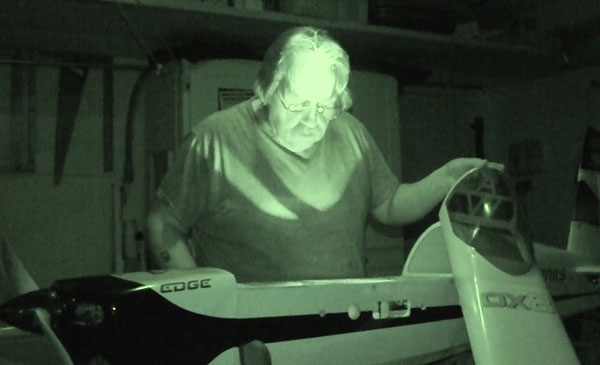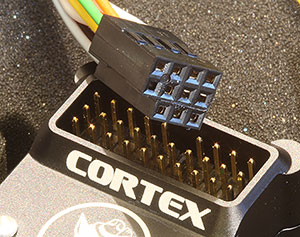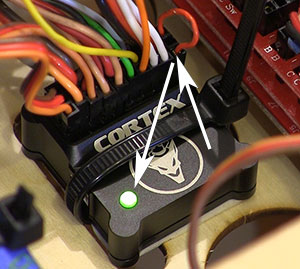



Text, photos and video by Tom Hintz Posted – 7-10-2015
Back when flybarless gyros for RC helicopters hit the market there was much gnashing of the teeth and not-so-subtle accusations of “cheating” directed at users of the technology. But when RC helicopters began to flourish, largely because they were flying more and crashing less it became perfectly acceptable to employ these technological wonders. To be sure, the BeastX-equipped Spektrum helicopter receiver was largely responsible for my being able to fly RC helicopters and saved me a ton of repair money in the process. Now we have the Bavarian Demon Cortex that is causing much of the same gnashing of the teeth and accusations of “cheating” in the fixed wing RC world.
I should note that after seeing a Bavarian Demon Cortex in action I decided to get one but keep it sort of a secret. I wanted to see if the change in how my Aeroworks 50cc Edge 540 flew would be obvious enough to make the others at our field suspicious of my suddenly improved skills. I even launched my “cover story” by accusing one of the Bavarian Demon Cortex users at our field of cheating…. The stealth world can be an ugly place.
The Bavarian Demon Cortex is a 3-axis gyro system designed specifically for fixed wing aircraft from park fliers to 3D giant scale and thrust vector turbine jets. You can even use the Bavarian Demon Cortex on canards! Using super high quality sensors the Bavarian Demon Cortex stabilizes five servo channels, most commonly two ailerons, two elevators and one rudder. Through the use of power boards you can have each of those channels apply the stabilization to multiple servos like on larger giant scale planes that have two or three servos per control surface.
The Bavarian Demon Cortex features a CNC-machined aluminum case that is 36 mm by 34 mm by 14 mm and weighs approximately 18 grams without the cables. It operates on 4-10 V (2S-LiPo-compatible, min. 5.5V using Spektrum/JR satellites) and is frequently used with power boards commonly found in giant scale aircraft.
Unlike some gyro systems the Bavarian Demon Cortex comes ready to use and requires only simple “teaching” using the plane and transmitter. Once “taught” that programming stays in the Bavarian Demon Cortex and you never have to do it again. Gains that control the amount of stabilization are adjusted in the transmitter. You can get the Bavarian Demon Cortex with the USB cable (as I did for this review) or purchase it separately to connect the Bavarian Demon Cortex to a PC for even more programming refinement.
Because of how it was designed the Bavarian Demon Cortex is compatible with all standard receivers plus various sum signal reception systems like S-bus (input), 2 spectrum/JR satellites and all PPM sum signals. Software and firmware updates can be downloaded from the Bavarian Demon Cortex web site and applied with the optional USB cable using the free software you can also download from their web site.

The wiring harness comes with it and
makes this installation a bunch easier.
Contrary to the incessant finger-pointing by the often self-anointed Internet wizards the Bavarian Demon Cortex does not take over flying the plane for otherwise inferior pilots. If you are prone to flying your planes into the ground or other obstructions turning the Bavarian Demon Cortex on will just make the plane more stable on the way to hitting whatever you aim it at.
A common and descriptive analogy is that the Bavarian Demon Cortex “turns the wind off” in its Normal mode. If you have flown any of the modern stabilization systems you know what they mean but the high end sensors in the Bavarian Demon Cortex put it head and shoulders over the cheaper gyros. In reducing the effects of wind the Bavarian Demon Cortex is remarkable and far beyond other gyros. Put it in the Hold mode where stabilization is more aggressive and higher gain values are typically used and the Bavarian Demon Cortex becomes spectacular. The manufacturer claims all this is due to their use of the finest sensors and electronics available and after experiencing the Bavarian Demon Cortex I can find nothing to refute those claims.

The lights are used to set the Demon up
and makes it much easier.
The small size and weight of the Bavarian Demon Cortex make installing it without seriously impacting the CG easy. In my Aeroworks 50cc Edge 540 I moved the main battery packs over a bit and that allowed me to install the Bavarian Demon Cortex just behind the CG and almost dead on the centerline of the plane.
You get two foam adhesive squares for mounting the Bavarian Demon Cortex and I used the thinner of the two. After sticking it to the floor of the interior I added a plastic tie wrap, snugged down lightly that is meant more to prevent the Bavarian Demon Cortex from working itself free than to actually hold it.
Wiring the Bavarian Demon Cortex looks scary but is really pretty easy. The cable bundle has a single, keyed plug that goes in to the unit and its color-coded wires are plugged into the receiver. I use the SmartFly Power Expander Pro so the Bavarian Demon Cortex goes between the signal wires coming out of the board and the receiver. I had to add common servo extension wires to the SmartFly signal wires for them to reach the Bavarian Demon Cortex located next to it. However you install the Bavarian Demon Cortex just start at the Aileron signal wire, put that in the Bavarian Demon Cortex’s first socket and then put the appropriate colored cable in the bundle into the Aileron socket on the receiver. A color-coded diagram on the Quick Start card makes this way easier to do than to describe.
The first two wires in the Bavarian Demon Cortex bundle take power from the receiver to power the gyro. As I worked my way down the line of wires I skipped the Gear signal wire as I use that for the ignition kill. The last wire, Aux3 on my receiver was used for the switch that controls the Bavarian Demon Cortex. I assigned the Aux2 three-position switch to Aux3 as that is easy for me to reach. On the SmartFly Power Expander plus I plugged the last signal wire into the Bavarian Demon Cortex and plugged the gray wire out of the Bavarian Demon Cortex into the Aux3 socket on the SmartFly board. This preserves the redundant power supply to the receiver from the SmartFly.
Before we can “teach” the Bavarian Demon Cortex how to deal with the controls we have to prep the transmitter. I zeroed out all of the dual rates for my Aeroworks 50cc Edge 540 and brought the expo down to 10% on all of the controls. (You may want higher expo but increase slowly and check the feel in flight.)
The gyro gains are controlled by the travel settings for the channel being used for the Bavarian Demon Cortex switch. Per the advice of Bavarian Demon Cortex I set my bank one to 20 and bank two to 50. You can adjust this later between test flights, on the ground, plane secured
To set up the Bavarian Demon Cortex a jumper plug is inserted into the first socket, very similar to binding a receiver to a transmitter. Then when the Bavarian Demon Cortex is powered up it will flash red twice and then go into the sequence of green flashes for setting up the control throws.
It is important to note that the series of flashes by the Bavarian Demon Cortex LED are telling you to do the next stick movement and not that the movement has been completed. A chart on the Quick Start card shows the control stick movements required after each set of LED flashes. When you complete the “teaching” the LED will go into a constant green flashing state meaning it is done. Remove the jumper BEFORE powering the Bavarian Demon Cortex down to lock the setup in its memory.
Next we power up the Bavarian Demon Cortex and make sure that the control movements are going the right way. Put the transmitter switch that controls the Bavarian Demon Cortex into the Hold or bank two position where the largest control surface movements are visible. Now move the tail of the plane up and the elevator should go up also to counter that movement. The same happens with the ailerons and rudder. When you roll or yaw the plane the control surface trailing edge should go in the same direction to counter the movement.
I was also advised that running the plane up while safely restrained on the ground before flying is just a good safeguard. Interference from electronic ignitions is rare these days but it is way better to find out about it on the ground than later in the air. I would be surprised to find such a problem in my planes with fiber optic ignition isolation but it is too easy to check. In addition to running the engine up I did a range check prior to flying, again just to error heavily on the side of caution.
The remarkable aspects of the Bavarian Demon Cortex so far are its small size and low weight that makes it compatible with a bunch of airplane sizes down to small foamies. Just as remarkable is how easy the Bavarian Demon Cortex is to install despite the look of being complicated. The wiring harness really does make installation simple and then the basic setup is just as easy and surprisingly quick.
Going from the box to flying the Bavarian Demon Cortex can literally be an hour-long proposition if you have the extensions needed when most power boards are involved.
The $289.99 price tag (7-1-2015) is nothing to sneeze at but if the Bavarian Demon Cortex prevents one wind related crash it will have paid for itself. Also there is no way to put a price on the hours of enjoyment many of us will get from a more stable airplane.
In the next segment we will look at flying the Bavarian Demon Cortex to see what it does, what it doesn’t do and if we need to change the gain settings. That story will be linked here when it is completed.
See the Bavarian Demon Cortex as I bought it – Click Here
Have a comment on his story? –Email Me!